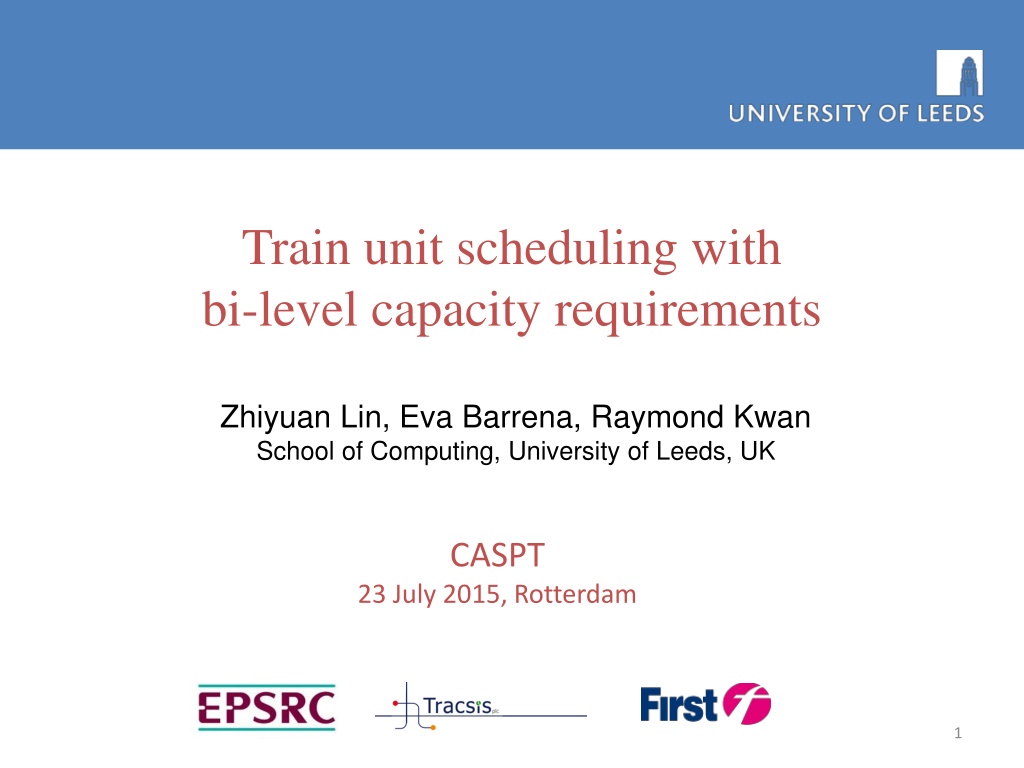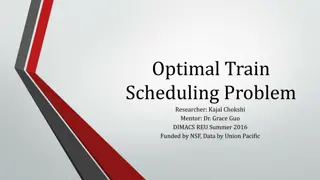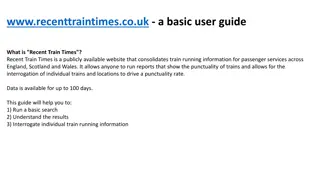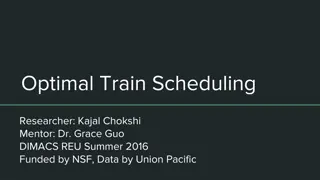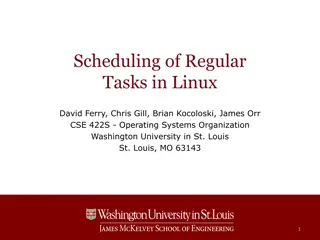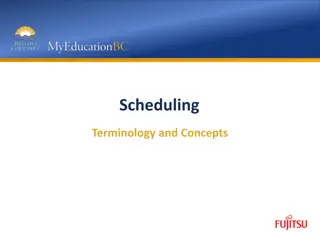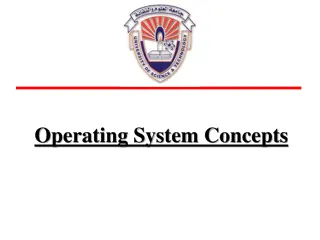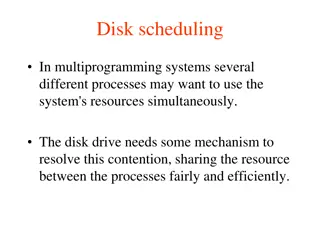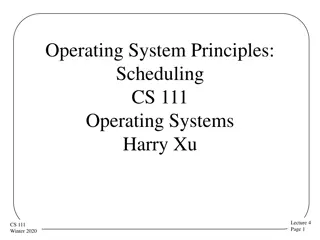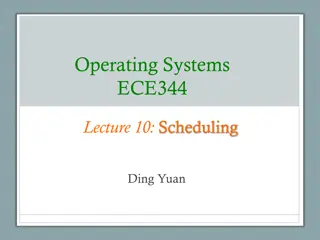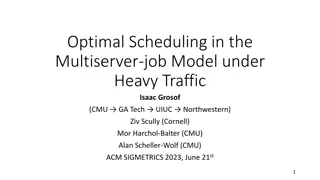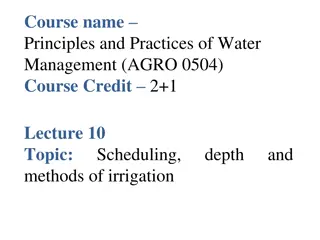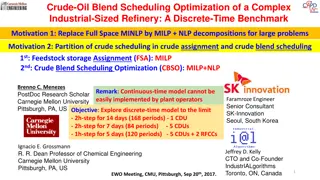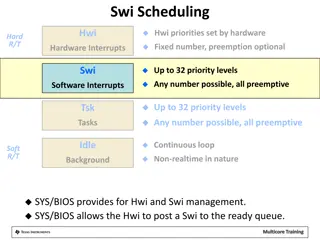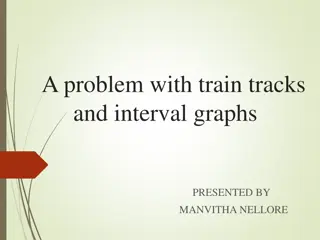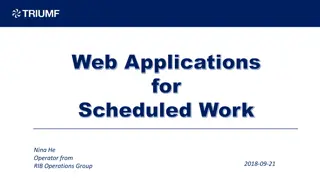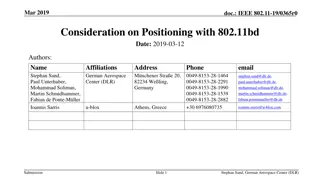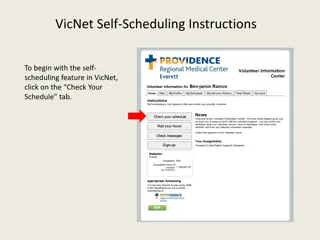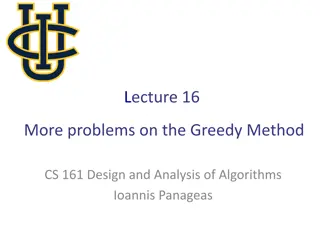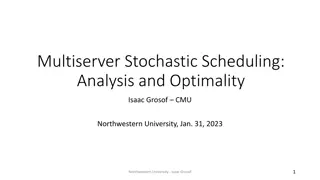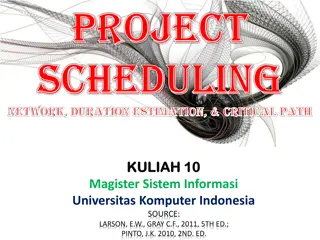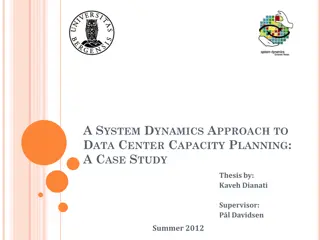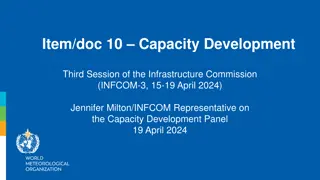Train Unit Scheduling Study: Optimal Capacity Management Approach
This study focuses on optimizing train unit scheduling by satisfying capacity requirements and minimizing operating costs. The research addresses imbalanced demands and under-utilized train units, proposing solutions for re-balancing. It explores integer multicommodity flow representation and methods for inferring train capacity requirements. The findings aim to enhance efficiency in train operations.
Download Presentation

Please find below an Image/Link to download the presentation.
The content on the website is provided AS IS for your information and personal use only. It may not be sold, licensed, or shared on other websites without obtaining consent from the author. Download presentation by click this link. If you encounter any issues during the download, it is possible that the publisher has removed the file from their server.
E N D
Presentation Transcript
INOC 2013 May 2013, Tenerife, Spain Train unit scheduling with bi-level capacity requirements Zhiyuan Lin, Eva Barrena, Raymond Kwan School of Computing, University of Leeds, UK CASPT 23 July 2015, Rotterdam 1
Outline Motivation Problem description - Capacity levels Model Computational experiments Conclusions and further work 2
Motivation Train unit scheduling problem Satisfy capacity requirements Minimize operating costs Various sources Best representation Imprecise definition How? Imbalanced demands Under-utilized train units Re-balance 3
Outline Motivation Problem description Capacity levels Model Computational experiments Conclusions and further work 4
Train units Class 171/7 (2-car), diesel Class 375 (4-car), electric 5
Train unit scheduling Train unit scheduling problem Train ID Origin Destination Dep time Arr time demands 2E59 2G15 2G71 A B C B C D 09:05 10:30 15:00 10:15 12:25 17:35 125 206 196 Train node Path (source to sink) Scheduled work for a train unit 2G71 C D Sign-off arc Empty-running connection arc source s Sign-on arc sink t Station connection arc 2E59 A B = ( { , }, ) G N s t A 2G15 B C 6
Train unit scheduling Integer multicommodity flow representation 1E06 1E06 1E09 1E09 x1 sink source 2E11 2E11 2E11 2E32 2E32 x1 2E03 2E03 Paths may overlap for coupling Coupled units may be of different but compatible types 7
Train capacity requirements Outline Capacity requirement can be inferred from: Mandatory minimum provision Historic provision Passenger count surveys (PAX) Future growth expectation Problems of a single level: Requirements not precisely defined / unknown Under-utilized train units as a result of optimization techniques 8
Historic capacity provision Outline Implicit information Pattern of unit resource distribution Agreements/expectations with transport authorities Potential problems Capacity strengthening could be used for unit resource redistribution: didn t reflecting the real level Unreasonable pattern may stay in past schedules for years 10
Historic capacity provision Outline Capacity strengthening for unit resource redistribution in historic provision: an example i A B Requires 1 unit m n B D D E Requires 1 unit Requires 2 units j C B Requires 1 unit 11
PAX surveys Outline Actual passenger counts Only a subset of trains surveyed Might contradict with historic provisions Frequency and scale of surveys vary among operators 12
OP and UP trains Outline Over-provided (OP): if historic capacity > PAX in terms of number of train units Under-provided (UP): if historic capacity < PAX No place available for coupling/decoupling Result of under-optimized schedules OP: Used for redistributing train unit resources UP: May be inevitable due to limited fleet size and/or coupling upper bound 13
Bi-level capacity requirement (per train j) Outline A desirable level r j Will be satisfied as much as possible max {historic, PAX, } A target level rj Must be strictly satisfied min {historic, PAX, } jr jr 14
Bi-level capacity requirement Outline Historic capacity PAX Desirable capacity Future growth Scheduled capacity Model Target capacity Mandatory minimum Output data information Input data 15
Outline Motivation Problem description Capacity levels Model Computational experiments Conclusions and further work 16
The integer multicommodity flow formulation Outline Objective function Minimize operating costs, including Fleet size, mileage, empty-running Reflect preferences on, e.g., long idle gaps for maintenance Achieve the desirable capacity requirements level as much as possible 17
The integer multicommodity flow formulation Outline Constraints Fleet size bounds Target capacity requirement Coupling of compatible types Complex coupling upper bounds combined into train convex hulls 18
The formulation Outline Variables Path variable number of units used for path p of type k k Z , , x p P k K + p ~ R , y j N N Capacity provision variable The capacity provided by the solver at train j + j 19
Desirable level r Outline Realized in the objective K k P p Operating cost j j + min C c x C y r 1 2 p p j Minimize the deviation between y and r ~ k N Desirable capacity level ~ N = , ; q x y j Get the capacity provision in constraints k p j k j k K p P j + + + Deal with the absolute values min ( ) C y y 2 j j ~ N j ~ N j + = , ; q x r y y j k p j j k j k K p P j 20
The ILP formulation Outline min K k j j + C c x C y r (1) Objective 1 2 p p j ~ k N p P k , ; x b k K (2) Fleet size upper bound p k p P j j , , ; H x d f F j N (3) Convex hulls for all trains , f k p f j k j k K p P j ~ = , ; q x y j N (4) Calculate capacity provision variables k p j k j k K p P j k Z , , ; (5)(6) Variable domain x p P k K + p R , y j N + j 21
Outline Motivation Problem description Capacity levels Model Computational experiments Conclusions and further work 22
Computational experiments: Objective function terms Objective function - Competing terms Deviation from desirable level Operating costs: Fleet size, mileage, ... ?2 ?1 Weights 23
Computational experiments Purposes Calibrate the objective function weights Satisfy as much as possible the desirable capacity level for a given fleet size Compare with manual schedules Experiments E1: Varying weights in the objective function E2: Fix fleet size & solely minimize r deviation 24
Computational experiments Central Scotland railway network; December 2011 timetable 25
Computational experiments: Input data Actually operated schedule: 64 OP trains out of 156 If use PAX, solver = 29 units If use historic capacity, solver = 33 units 26
Computational experiments: Results on E1 E1: Varying weights in the objective function. ?1+ ?2= 1 27
Computational experiments: Results on E1 Varying weights in the objective function?1+ ?2= 1 Experiments (increasing ?2) 28
Computational experiments: Results on E2 E2: Fix fleet size & solely minimize OP deviation 29
Computational experiments: Comparison between E1 & E2 E2 E1 Actually operating schedule: Fleet size= 33, OP=64 30
Conclusions Train unit scheduling with bi-level capacity requirements: Target: PAX; Desirable: historic provisions Schedules with more reasonable/controlled capacities Improvements w.r.t. manual schedules: 12% reduction of fleet size Maintaining nearly 60% OP trains 31
Further work UP trains & limited fleet size Multicriteria optimization Trade-offs between depot returns and maximizing capacity provision More problem contexts in train unit resource planning, e.g. franchise bidding maintenance scheduling 32
